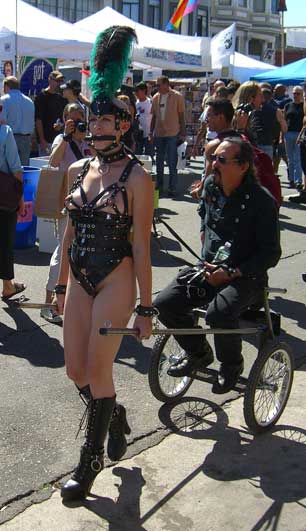
Photo by Pretzelpaws (license: CC BY-SA 3.0)

Photo by Pretzelpaws (license: CC BY-SA 3.0)
Cart ponies are ponies that are used to pull carts, carriages, chariots, sleighs, sulkies, wagons, and other such forms of transportation. Cart ponies can also be very show pony like, with fancy carts and tack. Cart ponies can be either two legged or four legged ponies. The two legged cart pony is the most common since human ponies are typically better able to pull a cart in two legged form; they can put more strength and power into each step. However, many four legged ponies make good cart ponies as well. Here are some definitions so you know what's what when it comes to horse pulled conveyances (these definitions are for vehicles pulled by real horses, but the definitions are essentially the same when pulled by human ponies):
I will use the term "cart" generically to refer to any of the above. Although this is not accurate, my purpose here is to give some general background information on cart ponies, and I think using the term as such will be good enough for the purposes of this article.
A cart pony will usually have tack that is somewhat specialized for this function, and the pony's Master/Mistress will of course need a cart for the pony to pull. The cart can come in many different sizes, shapes and constructions. The most common carts for ponyplay are constructed to seat one or two people and be pulled by a single pony; however larger carts are available or can be built. There are several carts that are designed to be pulled by a pair of ponygirls or ponyboys, and there are even some carts that are designed to be pulled by a team of 4, or even 6, human ponies. Carts, sleighs, etc. designed to be pulled by ponyboys or ponygirls are relatively expensive items, but if they are properly constructed, they should last for many years. Moreover, one can build a cart oneself instead of purchasing from a retailer. However, this often entails a reasonable amount of work, but more importantly, the cart should be constructed properly so that it will not pose a danger to the pony pulling it (for example when going downhill). There are several design plans available for human pony carts on the internet. I hope to post links, if not some of the plans themselves on this site in the near future.
In addition to carts, cart ponies will also benefit from other semi-specialized tack items. The obvious example is a set of long reins. A cart pony is typically several feet or more in front of the driver of the cart. This distance can be ever further when a team of four or six ponies is pulling a cart. Thus, the driver of the cart needs long reins to steer and stop the pony/ponies. Additionally, cart ponies can benefit from specialized waist belts and harnesses. These are not strictly necessary since in a simple sulky design the pony could just hold onto the "arms" of the sulky and pull it along. However, some carts do not have these arms, nor do chariots. In this case the pony needs to be attached by a harness in order to pull the conveyance. Additionally, attaching the cart to the pony's harness has the added benefit of distributing the load over a larger area, which reduces the amount of strain on the pony's arms. Finally, attachment of the cart to a pony's harness also allows the pony's arms to be bound up behind the back, which many find aesthetically pleasing. A common misconception is that a cart pony's tack must be very utilitarian. While it is true that cart ponies need to have tack that is functional and strong, their tack can also be aesthetically appealing depending upon how it is styled; the tack can also be colored, and the pony can have a plume. The best way to achieve this is by having tack custom made since a lot of the pretty tack out there might be a little lacking in strength and durability. Tack for a cart pony should be of high quality and able to withstand the load the pony will be pulling.
Cart ponies need to be physically fit to pull a cart and driver, and a good exercise regimen is recommended for cart ponies outside of ponyplay.